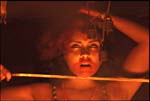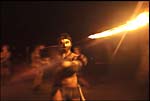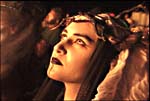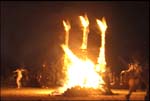Dream
Sequence 11
Phase Seven: The temple of Rudra
The performance was the one aspect of the production I had planned to shoot with a team. In an hour-long event taking place on an area the size of a football field, with outrageous moments happening everywhere, I simply needed the coverage. There were eight Scribes of Rudra (the keepers of history of this particular civilization used DV cameras instead of ink and papyrus), two still photographers, and six videographers. We had our own costumes and were our own mini-sect. This role let us shoot from within the performance with a minimum of distraction to the proceedings. Moreover, the reality of being one of the tribe was necessary to this event. Participation was mandatory, and I felt that this was a kind of breakthrough in documentary production, where the subject/object wall was dissolved. The Scribes were as much a part of the opera as anyone else.
There was one additional member of our contingent who carried something Ladd and I had designed the previous month in San Francisco. It was a large plastic globe that appeared to be an eyeball. It was about a foot in diameter and was mounted on a pole. There were two lights inside the globe, and they were controlled by switches farther down on the pole. It was powered by a 12-volt battery, which could be carried in a small backpack and slung over the user's back. One 12-volt light with a gel around it would illuminate the globe a bright reddish pink. The other switch controlled another 12-volt light, which shone out of a hole in the front of the globe. We called this lighting device/ceremonial object The Eye of Rudra. Not only was it our standard, it was used by The Bearer of the Eye to illuminate areas that required light for any of the Scribes who needed something they were shooting to be lit. Kelly Durkin, dressed only in outrageous black-and-white body paint, with multicolored film leaders streaming from her hair, bore the eye with a light grace and a wonderful sense of ceremony.
I knew from experience that shooting the opera well is an amazingly difficult task. It requires total concentration and awareness, as bits of magic would happen spontaneously all around. Although we knew the series of events that were supposed to occur (fondly called "the script"), there was a lot of room for improvisation from all the participants. I tried to limit everyone's shooting areas to certain quadrants to ensure coverage, but that didn't always come off as planned, as the camera people would see something happening and run over to it. Another instruction was to shoot everything at a shutter speed of 1/30 or 1/15 of a second. This boosted our low-light sensitivity and produced a strobe effect I felt was appropriate to the fantasy subject matter.
As it did the year before, the outrageously primal setting transported me to another time and place, with the uncanny sensation that I was inhabiting the dream of a god. Having been "here" before, I had an advantage the rest of the crew did not. For some, the intensity of the temple in flames and the presence of all this semiorganized madness made for some pretty distracted shooting, and much of the footage from that magical night proved unusable. But everyone's camera caught some of the amazing moments of the opera and helped to make what I believe is a totally unique document of a rare and beautiful event.
Next >>
|



